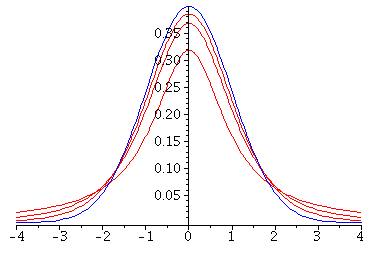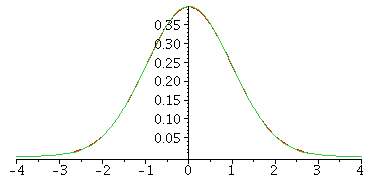
MONT 107N -- Understanding Randomness
``Student's'' t-distributions
March 29, 2010
| > | read "/home/fac/little/public_html/ProbStat0910/MSP.map": |
As we have said, there is one t-curve for each integer m ≥ 1.
This integer is called the number of ``degrees of freedom.''
(This is one of those cases where there is a reason for the name,
but it is rather technical. You might want just to take this as
a given. If you are interested, though, I can explain it in
office hours!)
The t-curve with m degrees of freedom is defined by the following
formula. (Here the Γ(x) is a function generalizing the factorial for
integers.)
| > | TPDF(m,y); |
 |
(1) |
Here are the graphs of several different t-curves in red, together with
the standard normal curve, in blue:
| > | TP:=plot([y->TPDF(1,y),y->TPDF(3,y),y->TPDF(7,y)],-4..4,color=red): |
| > | NP:=plot(y->NormalPDF(0,1,y),-4..4,color=blue): |
| > | with(plots): |
| > | display(TP,NP); |
 |
We see that the t-curves have shapes similar to that of the standard
normal curve, but with more probability "mass" concentrated in the tails,
and less concentrated around the average at 0.
As the number of degrees of freedom ![]() ->
-> ![]() , though, the t-curve
, though, the t-curve
approaches a standard normal normal curve. Here is the picture
for 100 degrees of freedom, together with the normal curve
(note that you cannot easily tell that there are two different curves here!)
| > | plot([y->TPDF(100,y),y->NormalPDF(0,1,y)],-4..4); |
 |
| > |